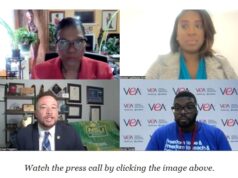by Atif Qarni, Virginia Secretary of Education
It’s encouraging to see people of all backgrounds and colors stepping up to speak out against systemic racism and injustices in our society. While it is important for people from outside of the Black community to rally for and support “Black Lives Matter,” true changes will only occur if policies and practices are reviewed and revised to support this claim. At the very local level, this starts with our city councils, board of supervisors, and school boards.
At this time in our country, people in power need to step up and use their positions of influence to effect positive change for communities of color. Now is the time to inventory the damage that our systems have wrought, and invest in changes that help the Black community not just survive, but heal and thrive.
As a local elected official, you have significant power to dismantle systems of oppression, which may include policies, practices, or processes that negatively impact the lives of Black people or people of color. This may seem like a daunting task, but the first step is actually a simple one. Look at your budget. Your budget reflects your values and where you are investing your resources. Ask yourself this question: Do these investments help the Black community in a meaningful way? Don’t look at your budget from the perspective of “all” – we have been doing this for too long and it’s not been working. If you need help understanding the needs of the Black community, reach out to the community and solicit input.
As I reflect on how I can take actionable steps to address inequities and disparities in education for communities of color, I want to offer some ideas for school board members across the Commonwealth to consider:
- Change school names and mascots that are offensive or that memorialize confederate leaders or sympathizers. The state does not have control over this, but localities do. The offensive names have a traumatizing impact on the psyche of our children, families, teachers and staff of color.
- Review and revamp your code of conduct and disciplinary policies to make them less punitive. These antiquated policies have had the most severe impact on our children of color because there is implicit and explicit bias that is factored into these practices and policies.
- Review your school boundaries. Some of our most diverse and Democratic-controlled locales have the most gerrymandered school districts where the district lines for the “best schools” are drawn to include affluent families (vs. non-affluent families) and single-family homes (vs. multifamily housing). If the quality of your education is based on the color of your neighborhood or income bracket, then we have to identify that for what it is—segregation by color and class.
- Review your local grading policies. Many grades are not based solely on content knowledge – they can include behavior, participation and other subjective measures, which can place students of color at a distinct disadvantage. Antiquated grading policies have had the most severe impact on our children of color. There are research-based grading structures that I highly recommend school divisions consider, which are fair and remove bias from the equation.
- Review the demographics of your teachers and staff, administrators, directors, associate superintendents and superintendents and compare that with the demographics of the students served. From my visits across the Commonwealth, it’s glaringly obvious that large disparities exist. Fix your hiring practices and make them fair for people of color. I hate to say this, but it was easier for me to become the Virginia Secretary of Education for our state than to become a local school administrator. If you are having problems with finding diverse applicants, invest in recruiting efforts at Historically Black Colleges and Universities and Hispanic Serving Institutions.
- Make it mandatory for all educators and staff to attend Professional Development on Diversity, Equity and Inclusion. These trainings are generally well attended by people of color but since they are not mandatory, the target audience is not receiving this much needed training.
There are many more actionable steps to take, but I think this is a good place to start. Now, let’s get to work.



 Sign up for the Blue Virginia weekly newsletter
Sign up for the Blue Virginia weekly newsletter








